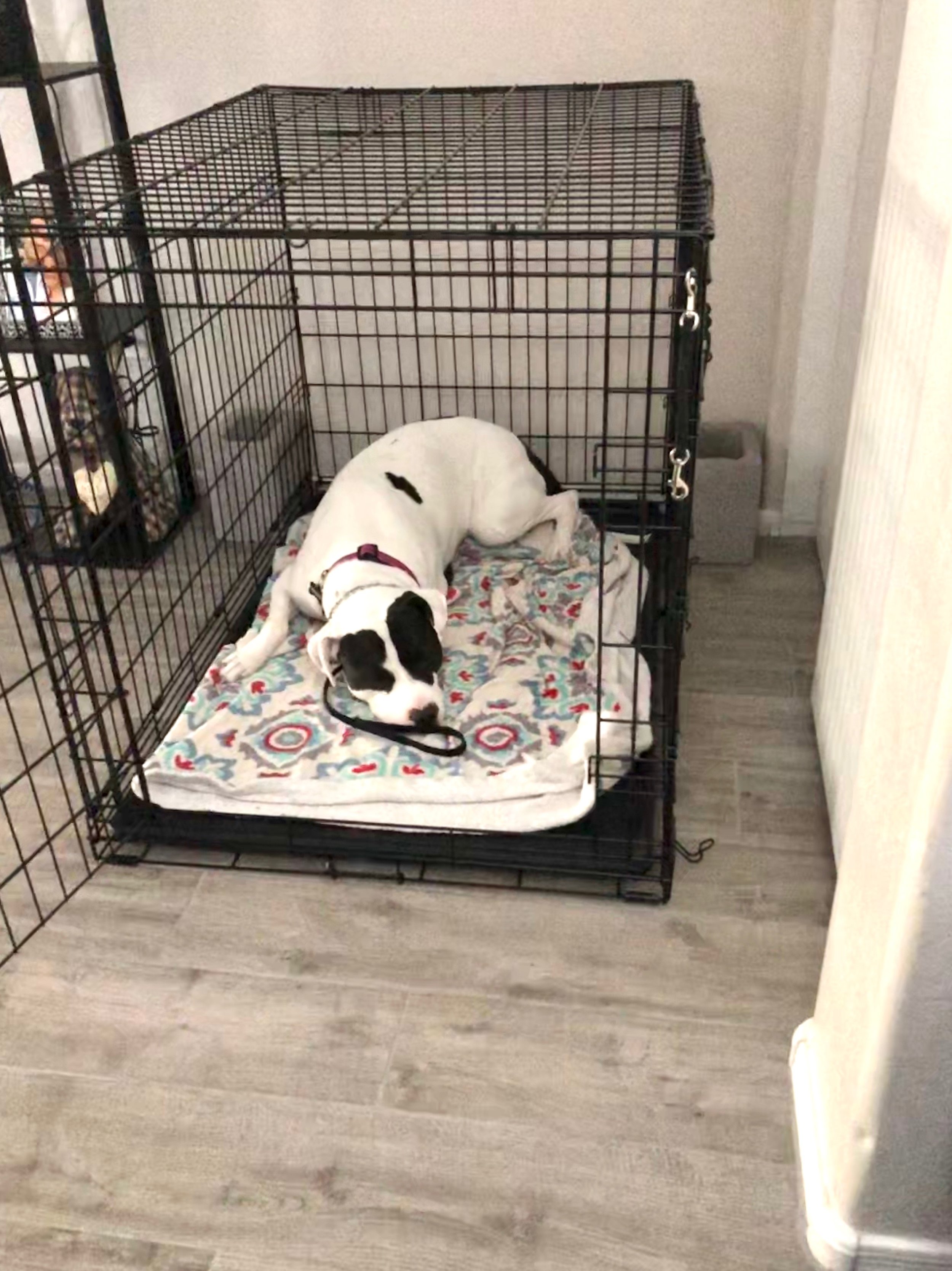Is It Okay to Crate a Dog While at Work? Crating a dog while at work can be okay for short periods. Ensure your dog is comfortable, and provide enough exercise and stimulation.
Crate training is a common practice among dog owners, especially those who work long hours. A crate can serve as a safe haven for your dog, providing them with a space to relax and feel secure. However, crating for extended periods can lead to anxiety and behavioral issues.
It’s essential to balance crate time with regular exercise and mental stimulation. Dogs need social interaction, so consider alternatives like doggy daycare or hiring a pet sitter. Understanding your dog’s individual needs will help you make the best choice for their well-being while you’re away at work.

Credit: www.sadiesrulesk9training.com
Table of Contents
Introduction To Crating Dogs
Crating dogs can be a helpful tool for many pet owners. It provides a safe space for dogs while their owners are at work. Understanding the benefits and drawbacks is essential. This section explores the pros and cons, along with the historical perspective.
Pros And Cons
| Pros | Cons |
|---|---|
| Creates a safe space for dogs. | Can cause anxiety if overused. |
| Helps with house training. | May lead to loneliness. |
| Prevents destructive behavior. | Not suitable for all dogs. |
| Offers a sense of security. | Requires proper introduction. |
Historical Perspective
Crating has roots in dog training. Early dog trainers used crates to manage dogs. They recognized crates help create a den-like environment. Dogs feel safe in smaller, enclosed spaces.
Modern pet owners often rely on crates. Many shelters and trainers recommend crating. It helps dogs learn boundaries and routines. Understanding this history aids in responsible crating practices.
Crating Basics
Understanding the basics of dog crating is essential. Crating can provide a safe space for your dog. It helps with training and reduces anxiety. Let’s explore what a dog crate is and the types available.
What Is A Dog Crate?
A dog crate is a confined space designed for dogs. It acts as a den, providing security and comfort. Crates are often used for:
- House training
- Travel safety
- Preventing destructive behavior
- Creating a safe space for rest
Dogs naturally seek small, enclosed areas. A crate mimics that instinct. Always ensure the crate is a positive space. Never use it for punishment.
Types Of Crates
There are several types of dog crates. Each type serves different needs. Here’s a quick overview:
| Type of Crate | Description |
|---|---|
| Wire Crate | Durable and well-ventilated. Ideal for indoor use. |
| Plastic Crate | Lightweight and portable. Good for travel. |
| Soft-Sided Crate | Lightweight and easy to carry. Best for calm dogs. |
| Heavy-Duty Crate | Sturdy and secure. Great for strong or escape-prone dogs. |
Choose the right crate based on your dog’s size and needs. Ensure it’s comfortable and safe. A well-chosen crate can benefit both you and your dog.
Reasons For Crating
Crating a dog can have many benefits. Understanding these reasons helps you decide if it’s right for your pet.
Safety Concerns
Keeping your dog safe is a top priority. Crating can prevent accidents at home. Here are some key safety reasons:
- Prevents Chewing: Dogs often chew on dangerous items.
- Avoids Injuries: Dogs can get hurt from falling objects.
- Stops Escaping: Crating keeps your dog from wandering off.
Crates create a secure space. This is especially important for:
| Dog Age | Common Risks |
|---|---|
| Puppies | Chewing on cords, swallowing small objects |
| Adult Dogs | Escaping, damaging furniture, or getting into harmful items |
Training Purposes
Crates can aid in training your dog. They help teach good behavior.
- House Training: Dogs learn to hold their bladder.
- Desensitization: Dogs get used to being alone.
- Establishing Routine: Dogs thrive on consistency.
Using a crate for training can include:
- Start with short periods.
- Gradually increase crate time.
- Reward your dog for calm behavior.
With patience, crating can lead to a well-adjusted dog.

Credit: jetpetresort.com
Crate Training 101
Crate training helps dogs feel safe. It provides them with a personal space. A crate can also prevent destructive behaviors. Understanding how to crate train is crucial.
Steps To Effective Crate Training
- Choose the Right Crate: Pick a size that fits your dog. It should be big enough to stand, turn, and lie down.
- Make it Comfortable: Add a soft blanket or bed. Toys can make it more inviting.
- Introduce the Crate Gradually: Let your dog explore it. Use treats to encourage them inside.
- Start with Short Periods: Close the door for a few minutes. Gradually increase the time.
- Use Positive Reinforcement: Praise your dog for entering. Reward them with treats.
- Establish a Routine: Crate them at the same times daily. Consistency helps them adjust.
Common Mistakes
- Using the Crate as Punishment: This creates fear. Dogs should feel safe in their crate.
- Leaving Them Too Long: Puppies have small bladders. Adults need breaks too.
- Forgetting to Exercise: A tired dog is a happy dog. Walk them before crating.
- Not Making it Comfortable: A bare crate feels unwelcoming. Add bedding and toys.
- Rushing the Process: Take time to build comfort. Patience is key.
| Tip | Importance |
|---|---|
| Positive Reinforcement | Builds trust and comfort |
| Routine | Helps dog adjust faster |
| Comfort | Encourages use of crate |
The Debate: Crating During Work Hours
Crating dogs while at work sparks strong opinions. Some believe crating is beneficial. Others argue it can be harmful. Understanding both sides helps dog owners make informed choices.
Supporting Arguments
Many dog owners support crating for various reasons:
- Safety: Crates keep dogs safe from hazards.
- House Training: Crating helps with potty training.
- Reduces Anxiety: A crate provides a personal space.
- Prevents Destruction: Dogs cannot chew furniture or shoes.
Crates can also be a refuge. Dogs often feel secure in their space.
Opposing Views
Critics of crating raise important concerns:
- Loneliness: Dogs may feel isolated when crated.
- Physical Discomfort: Crates can be too small for some dogs.
- Behavioral Issues: Long crating can lead to anxiety.
- Socialization: Crated dogs miss out on interaction.
Dogs thrive on companionship. Long hours in a crate may not be healthy.
| Pros of Crating | Cons of Crating |
|---|---|
| Provides safety | Can cause loneliness |
| Aids in house training | May lead to behavioral problems |
| Prevents damage to home | Limits social interaction |

Credit: healthyhoundz.com
Welfare Implications
Crating a dog while at work raises important welfare concerns. It impacts their mental and physical health. Understanding these implications helps pet owners make informed choices.
Psychological Effects
Crating can affect a dog’s mental well-being. Some dogs feel secure in a crate, while others may feel isolated.
- Stress Levels: Long hours in a crate can increase stress.
- Anxiety: Dogs may develop separation anxiety.
- Boredom: Lack of stimulation can lead to destructive behaviors.
Signs of distress include:
- Barking excessively.
- Chewing on the crate.
- Pacing inside the crate.
Physical Health
Physical health also suffers when dogs are crated too long. Limited movement can lead to several issues.
| Health Issue | Description |
|---|---|
| Obesity | Less exercise can cause weight gain. |
| Joint Problems | Restricted movement may lead to stiffness. |
| Urinary Tract Issues | Holding bladder for too long can cause infections. |
Provide regular breaks and exercise. This helps maintain their physical health. A balanced routine promotes overall well-being.
Alternatives To Crating
Crating a dog can feel restrictive. Thankfully, many alternatives exist. These options keep your furry friend happy and safe while you work.
Dog Sitters And Daycares
Hiring a dog sitter or enrolling your dog in daycare can be great choices. Here are the benefits:
- Social Interaction: Dogs enjoy playing with others.
- Exercise: They get plenty of physical activity.
- Less Anxiety: Your dog feels more secure with company.
Consider the following options:
| Option | Pros | Cons |
|---|---|---|
| Dog Sitter | Personalized care | Higher cost |
| Dog Daycare | Socialization | Can be overwhelming |
Pet-friendly Workplaces
Some workplaces welcome dogs. This option offers many advantages:
- Reduced Stress: Dogs provide comfort during work.
- Increased Productivity: Short breaks with pets can boost focus.
- Improved Morale: A dog-friendly environment creates a happy workplace.
Check if your workplace allows pets. Talk to your employer about policies. A pet-friendly workplace benefits everyone.
Best Practices For Working Dog Owners
Working dog owners face unique challenges. Balancing work and pet care is essential. Here are some effective practices to help you manage your dog’s needs while working.
Balancing Work And Pet Care
Creating a balance between work and your dog’s care is crucial. Here are some tips:
- Understand your dog’s needs.
- Know the best crate duration.
- Choose the right crate size.
- Provide engaging toys.
Short breaks can help. Use your lunch hour for a walk. This keeps your dog happy and healthy.
Creating A Dog-friendly Schedule
A dog-friendly schedule helps both you and your dog. Follow these steps:
- Set a regular feeding time.
- Plan for potty breaks.
- Include playtime in your schedule.
- Consider a dog walker for long days.
Here’s a simple table to visualize a daily schedule:
| Time | Activity |
|---|---|
| 7:00 AM | Morning walk |
| 8:00 AM | Feeding |
| 10:00 AM | Potty break |
| 12:00 PM | Lunch break |
| 3:00 PM | Potty break |
| 5:00 PM | Evening playtime |
Following a schedule helps your dog feel secure. A happy dog leads to a happy owner.
Expert Opinions
Understanding whether it’s okay to crate a dog at work requires expert insights. Veterinarians and animal behaviorists provide valuable information. Their opinions help dog owners make informed choices about crate training.
Veterinarian Insights
Veterinarians often highlight the importance of crate training. A crate can provide a safe space for dogs. It helps with anxiety and prevents destructive behavior.
Key points from veterinarians include:
- Safety: Crates keep dogs safe from hazards.
- Comfort: Dogs may enjoy their own space.
- Training: Crates assist with house training.
Most vets recommend crating for limited periods. A dog should not be crated for over 4-6 hours. Puppies and young dogs may require shorter durations.
Animal Behaviorists’ Advice
Animal behaviorists focus on a dog’s mental health. They emphasize proper crate training techniques. Positive reinforcement is essential for success.
Important advice from behaviorists includes:
- Introduce the crate gradually.
- Use treats and praise during crate time.
- Avoid using the crate as punishment.
Behaviorists suggest observing your dog’s reaction. If a dog shows signs of distress, reevaluate the crate duration. Every dog is unique and needs individual attention.
Legal And Ethical Considerations
Crating a dog while at work raises important legal and ethical questions. Understanding these aspects is crucial for responsible dog ownership. This section explores animal rights laws and the moral responsibilities of dog owners.
Animal Rights Laws
Animal rights laws protect dogs from abuse and neglect. Each state has its own regulations. Here are key points to consider:
- Humane Treatment: Laws require that dogs receive adequate care.
- Space Requirements: Crates must be appropriately sized.
- Time Limits: Restrictions on how long dogs can be crated.
- Ventilation: Crates must allow for proper airflow.
| Law | Description |
|---|---|
| Animal Welfare Act | Sets standards for humane treatment of animals. |
| State Laws | Each state has specific regulations for pet care. |
Moral Responsibilities Of Dog Owners
Dog owners have ethical duties. These responsibilities ensure dogs live happy and healthy lives.
- Provide Exercise: Dogs need daily physical activity.
- Socialization: Dogs require interaction with people and other pets.
- Training: Proper training helps reduce anxiety.
- Comfort: Ensure the crate is a safe and cozy space.
Crating should never be a punishment. Instead, it should provide a safe environment. Responsible owners balance crate time with love and care.
Frequently Asked Questions
Is Crating A Dog While At Work Safe?
Crating a dog while at work can be safe if done correctly. Dogs generally feel secure in a crate. However, ensure your dog is crate-trained and comfortable. Provide water, toys, and a cozy blanket. Avoid leaving them in the crate for too long to prevent anxiety.
How Long Can A Dog Stay In A Crate?
A dog should not stay in a crate for more than 4-6 hours. Puppies need more frequent breaks, while adult dogs can handle longer periods. Always consider your dog’s age, health, and temperament. Make sure to provide regular exercise and bathroom breaks to keep them happy.
What Are The Benefits Of Crating A Dog?
Crating a dog offers several benefits. It provides them with a safe space, reduces anxiety, and can aid in house training. A crate can also prevent destructive behavior when you’re away. Additionally, it helps establish a routine, making your dog feel more secure in their environment.
Can Crating Cause Separation Anxiety In Dogs?
Yes, crating can contribute to separation anxiety in some dogs. If a dog feels isolated or confined for too long, they may develop anxiety issues. To prevent this, gradually introduce crating and associate it with positive experiences. Always ensure your dog has enough exercise and social interaction.
Conclusion
Crating a dog while at work can be a viable option. It offers a safe space for your furry friend. Ensure your dog is comfortable and gradually acclimated to the crate. Always provide sufficient exercise and mental stimulation. With the right balance, crating can enhance your dog’s well-being and your peace of mind.



